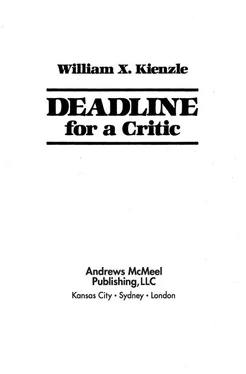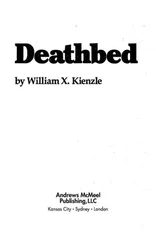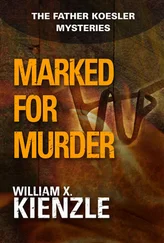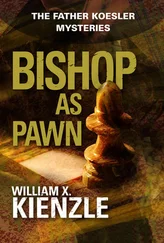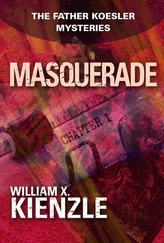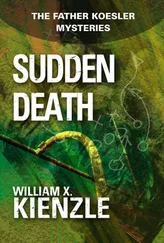“And that’s what it comes down to, Bob. I long ago forgave what he did to me. And I didn’t do anything to him.” Mitchell looked reflective. “And God knows I could have.”
Catching Mitch’s eye and directing his gaze briefly at Lynn, Koesler asked, “Have you ever told—?”
Mitchell shook his head. “No reason to. It’s between Rid and me.”
Interesting, thought Koesler. Mitchell had freely shared with his wife a most embarrassing and compromising incident that had happened to him. If he had been in Mitchell’s shoes, he might have hesitated many times before telling his wife about having been in bed with another woman, no matter how innocent it might have been or how long ago it had happened.
Yet Mitchell told Lynn that, but hadn’t revealed to her that the man she so heartily disliked, the celebrated critic, had once been guilty of a most deliberate and flagrant plagiarism.
Koesler’s respect for Mitchell increased; he had done very well, indeed, at keeping secrets.
“What it comes down to, dear,” Lynn said, “is that you can’t think of a reason why that creep has done this to you. So, because you can’t come up with a motive, you deny a proven fact. I talked to them! I talked to producers, directors, even other critics. Some of them weren’t even all that aware of what had been going on until I came right out and asked. Then, almost all of them could recall times when Groendal had put you down, denigrated you, both personally and as a writer; made it evident that they would be fools or jackasses to stage any of your work, or even to be kind—much less fair—to you.
“He let it be known—made it very clear—that were they to ignore his advice, his future reviews—not only of your plays, but of all their productions in general—would be critical and belittling. And because he wielded a long pen—and a long memory—it would have taken a very gutsy—foolishly gutsy—director to cross him.”
She turned to her husband. “These are the facts, whether you can find a motive for them or not!”
Mitchell didn’t reply, though the conversational ball was definitely in his court. Finally, he said, “I can’t help it. It just doesn’t make sense . . . oh, don’t get me wrong, Lynn; I don’t doubt for a moment that the people you talked to said what you say they said. And I’m not ungrateful for all your legwork. But it just doesn’t make sense. Maybe they’re confused. Or maybe they’ve got an axe to grind with regard to Rid. Maybe that’s it. I don’t know.” He looked at Koesler. “What do you think, Bob?”
“I don’t know. It’s hard to say. Rid always had a . . . different mind. It’s just hard to tell.”
“Hmmm. Well, you know him better than I do. Hell, you both came from Redeemer parish, didn’t you? And now . . . God, now he’s your parishioner! But I just can’t see it.”
“Well, it’s very interesting,” Koesler said. “Tell me, Mitch: Suppose it were true. Suppose what Lynn discovered is absolutely true. Supposing Rid has effectively blocked your whole career as a playwright. Just suppose, for whatever reason it’s true. Then what?”
A long period of extended silence followed while all three pondered the question, What if . . .
“What if, eh?” Mitch said, finally. “What if Rid has actually blocked me from what I love most next to Lynn and the kids? What if he’s done that?
“I’d kill him!”
Lynn laughed, a bit nervously. “Well, that just proves that Mitch can keep up his sense of humor.”
They all laughed.
But Carroll Mitchell and Father Koesler both knew the laughter was not genuine.
19
“The body of Christ.”
“Amen.”
Father Koesler had been distributing Communion for slightly more than thirty years. Unlike many other priests, he never tired of it.
The distribution of Holy Communion had gone through many stages, as had almost every other ritual in the liturgy since the Second Vatican Council.
At the time Koesler was ordained, and for hundreds of years prior to that, Communion was given by the consecrated hands of a priest alone. Outside of the most dire emergency, no lay person ever touched a consecrated host. That was a time when there were, proportionately, more priests and fewer communicants than today. When the balance tipped in the other direction, the laity was urged to exercise the “priesthood of baptism” and become “extraordinary ministers” of the Sacrament. It was, Koesler believed, a variation of Parkinson’s Law. In this case, lay sacramental functioning tends to multiply in direct proportion as there are fewer priests around to perform sacramental tasks.
The pre-Vatican II formula for distributing Communion was a comparatively long Latin invocatory prayer. Now, the minister of the Sacrament merely held aloft the consecrated host and announced, “The body of Christ.” And the recipient responded with the affirmation, “Amen.”
Koesler remembered well when that formula was in transition and the current form was in vogue but still in Latin. He recalled a Sunday when he presented the host to a young lady, saying “Corpus Christi.” To which she responded, “Texas.”
Gaffes like that could be expected but not foreseen. But it added a measure of innocent humor to what could easily become stuffy repetition.
The line of communicants kept coming. Evidently, there were a surprising number of Catholics at this funeral. Even though several priests were helping with the distribution, the time for giving Communion was proving to be unexpectedly long. Of course, it took longer now since communicants had the option of receiving under the form of wine as well as bread, and the chalice had to be wiped after each person sipped.
Koesler selected another wafer, held it over the brim of the ciborium and looked at the next communicant. It was Charles Hogan.
“Charlie, the body of Christ.”
“Amen.”
While he continued the distribution of Communion, Koesler’s thoughts, as usual, wandered. Jogged by the memory of his conversation with Carroll and Lynn Mitchell, Koesler recalled a similar talk he had had recently with Charlie Hogan.
That Hogan and Koesler had remained active friends was a little out of the ordinary. Generally, after leaving the priesthood, a man quite naturally traveled in different circles, made new friends. No longer sharing common interests, the resigned priest usually drifted away from former comrades. It was an understandable phenomenon. But with Koesler and Hogan it had been different.
That Koesler had been selected and invited to witness Charlie’s marriage to Lil was evidence of the depth of this friendship. Seldom does a bride or groom know a priest well enough to request him to witness their wedding. But when such a request is made, it usually signifies some degree of friendship along with a good measure of respect.
This demonstration of friendship by no means ended with the Hogans’ wedding. Koesler and Charlie met periodically. Occasionally Koesler would dine with the Hogans. The priest was aware that Charlie and Lil were far from wealthy. The fact that they were meticulous in keeping up their house and that they ate simple though nourishing meals did not conceal their comparatively spartan existence.
As far as Koesler could tell, Charlie’s membership in a local health club was his sole “extravagance.”
Several months ago, Koesler had joined Hogan at the club. On the agenda were a few games of racquetball, a swim and sauna. Not slated was a conversation about Hogan’s material status, his work, his income, his prospects. The conversation did not take place until the sauna. The swim and particularly the racquetball had pretty well wiped out Father Koesler, who was breathing heavily while perspiring freely.
Читать дальше
